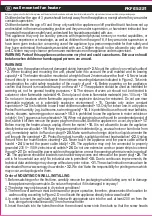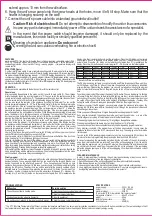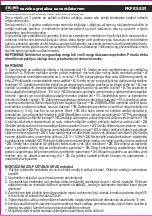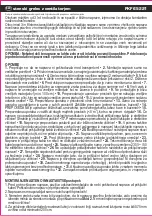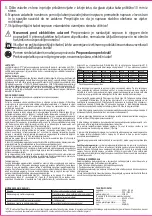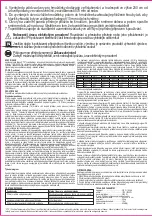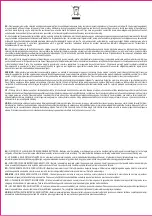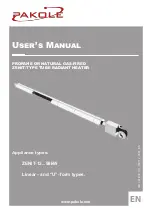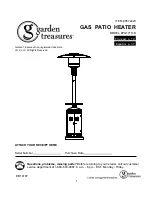
extend approx. 10 mm from the wall surface.
6. Hang the unit’s rear panel onto the screw heads at the holes, move it left, till stop. Make sure that the
heater is hanging securely on the wall!
7. Connect the unit’s power cable into a standard grounded wall outlet!
Caution: Risk of electric shock!
Do not attempt to disassemble of modify the unit or its accessories.
In case any part is damaged, immediately power off the unit and seek the assistance of a specialist.
In the event that the power cable should become damaged, it should only be replaced by the
manufacturer, its service facility or similarly qualified personnel.
Meaning of symbol on appliance:
Do not cover!
Covering the unit can cause overheating, fire or electric shock!
TROUBLESHOOTING
Malfunction
The unit does not heat in heating mode.
Overheating protection activates frequently.
The unit does not respond to the remote control's signal.
Possible solution
Check the section on overheating protection!
Check the thermostat settings!
Clean the appliance!
Check the remote control's batteries!
SPECIFICATIONS
power supply:............................... 230 V
~
/ 50 Hz
output: ......................................... 1
1
00 / 2
2
00 W
maximal output:............................ 2
2
00 W
IP protection:
IP20: Not protected from ingress of water!
dimensions of heater:.................... 65 x 25 x 15 cm
weight:.........................................
4,2
kg
length of power cable:...................1,5 m
sound pressure: ...........................
60
dB(A)
* The PTC (Positive Temperature Coefficient – positive temperature coefficient) is a ceramic polycrystalline semiconductor, alloyed with barium and titanium. The real advantage is that it
has temperature self-regulating ability, so you do not need any precautions against overheating, and the device is considerably energy-saving.
FEATURES
wall mounted PTC* fan heather for heating the air of indoor premises • adjustable output (1100 /
2200 W) • operation modes: warm, hot air • switchable air deflection • built-in thermostat •
overheating protection • 8-hour switch of timing • weekly program • temperature display • with
remote control
STRUCTURE (figure)
1.
cold air inlet
2.
main switch
3.
power cable
4.
mounting points
5.
warm air outlet
6.
swinging air
deflector blade
7.
display
8.
8-hour switch off timer
9.
heating stage selector
10.
screws, dowels 11.
fan mode indicator
12.
heating stage indicator – 1100 W
13.
heating stage indicator – 2200 W
14.
continuous air deflection indicator 15. weekly program indicator
16.
temperatures setting / window
opening indicator
17.
on/off switch
18
. window opening sensor
19.
heating stage selector
20.
continuous air deflection indicator 21. switch off timer
22.
temperature setting
23.
weekly program
24.
selector buttons
25.
OK
26.
exit
OPERATION
The device can be operated with the buttons on it or with the remote control.
General use
After connecting the appliance to the mains, switch it on with its main switch (2). Then it beeps
briefly, the display shows the room temperature in °C. You can switch the appliance on with the
remote control’s switch on/off button (17). The appliance switches on in fan mode, it does not heat.
Use the remote control’s (19) button to select the heating stage, or fan mode.
You can also adjust the operation of the appliance by setting the thermostat. You can set the
desired temperature between 18 - 45 °C with the remote control’s (22) button, then by pressing the
+/- selector buttons. If the set temperature is higher with 1 – 2 °C than the measured temperature,
the appliance operates in low heating stage. If the set temperature is at least 3 ° C above the
measured temperature, the unit operates at high heating stage. If the room temperature reaches
the set temperature, the unit switches to fan mode. When the appliance is operating in thermostat
mode, the indicator (16) is lighting continuously on the display. You can switch off the thermostat
function at any time by pressing the remote control’s (19) button, by selecting heating stage, or by
pressing the (22) button, then pressing the (26) button on the remote control.
Use the (18) button on the remote control to switch on/off the window opening sensor. If the
function is active, the indicator (16) is flashing continuously on the display. If the function is active,
the appliance records the measured temperature 1 minute after the function is switched on, then
compares the actual measured temperatures with this value in every 5 minutes. If the current
measured temperature is at least 8 °C lower than the original measurement, the unit switches off
for energy saving reasons.
Use the (21) button on the remote control to set switch off timing, up to 8 hours, per hour. You can
switch off this function by setting 0 hour as switch off time.
Use the remote control’s (20) button to switch on/off the continuous air deflection. If the function is
active, its indicator (14) is continuously lighting on the screen.
With the (9) buttons on the front of the product, you can switch on the appliance ready for
operation. Pressing the button once switches the appliance to fan mode. By pressing the button
again, it switches to low heating stage, and by pressing once more, it switches to high heating
stage. By pressing the button again, it switches the appliance’s continuous air deflection on, during
high heating stage. Pressing the button again switches the appliance off.
After switching off the appliance, it may still operate in fan mode for about 30 seconds, then the fan
mode indicator blinks, and the appliance counts down. Do not unplug the appliance from the mains
until it is switched off, because it may cause damage to it.
Weekly program
You can only set or activate the weekly program function while using one of the heating stages, not
besides fan mode. To use weekly program function, you need to set the time and date on your
device. You should do this after every power off. If you have already set the time on your
appliance, then you cannot change it. In this case, you can choose from the programs directly after
pressing the (23) button. The exact time can only be reset after the power is switched off and
switched back on. To set the exact time, press the remote control’s (23) button. You can read 01 on
the display – use the +/- selector buttons to set the actual days of the week (01 – Monday, 02 –
Tuesday, etc.). Press the (23) button on the remote control again, then 00 is readable on the
display. Use the +/- selector buttons to set the actual hour. Press the (23) button on the remote
control again, then 00 is readable on the display again. Use the +/- selector buttons to set the
actual minute. Press the (23) button on the remote control again, then P1 is readable on the
display. Press the (23) button again to select program P1 – P6, as shown in the following table:
*: the switch off time is at a different day
The P6 program can be set freely, you can set a switch on/off time for each day of the week. If you
set 00 to power on/off time for a day of the week, the appliance will not perform a scheduled
program that day. When setting the program, you can only set whole hours during the program
setup, not minutes. Make sure, that on the given day the switch off time is set after the switch on
time.
To set the program, select P6 program, then press the OK button. Then on the display 1 is flashing
– Monday. Press the OK button, on the display 00 is lighting, use the +/- selector buttons to set the
switch on hour. Press the OK button, on the display 00 is lighting, use the +/- selector buttons to set
the switch off hour. Press the OK button on the display, 2 is flashing on the display – Tuesday. After
setting the switch off time on Sunday and pressing the OK button, the program is active.
Whenever you select the P6 program, you can always change the previously set program. By
pressing the OK button several times, repeatedly to scroll through the previously set values and
either change or leave them.
When you power off the appliance, it forgets the exact time and program set for the P6.
If any program is selected, the unit operates in the most recently used mode – or in any of the
heating stages, or according to the temperature set in the thermostat mode.
If the weekly program is active, the indicator (15) is lighting on the appliance’s display.
If the program is active but the device is not working, the indicator (15) is flashing.
You can switch on/off continuous air deflection at any time during weekly program operation.
If any program is selected, if the program does not function when selected, in some cases the
appliance switches to fan mode for 30 seconds and then stop. The swinging air deflector blade
remains open.
You can switch off the weekly program operation at any time, by pressing the (23) button on the
remote control to enter programming, then pressing the remote control’s (26) button.
In case of overheating, the overheating protection function will switch off the unit, for example,
when the air inlets and outlets are covered. Power off the unit by unplugging it from the electric
outlet. Allow the appliance to cool (for at least 30 minutes). Check whether the air inlets and outlets
are obstructed or not, and clean them if necessary. Switch on the unit again. If the overheating
protection activates again, power off the unit by unplugging it from the electric outlet and contact
the service facility.
CLEANING, MAINTENANCE
In order to ensure optimum functioning, the unit may require cleaning at least once a month,
depending on the manner of use and degree of contamination.
1. Switch off and power off the unit by unplugging it from the electric outlet before cleaning.
2. Allow the appliance to cool (for at least 30 minutes).
3. Use a vacuum cleaner with a brush attachment to clean the air inlet and outlet openings.
4. Use a slightly moistened cloth to clean the unit’s exterior. Do not use any aggressive cleaners.
Avoid getting water inside the unit and on the electric components!
Program Monday
Tuesday
Wednesday Thursday
Friday
Saturday
Sunday
P1
8:00-17:00
8:00-17:00
8:00-17:00
8:00-17:00
8:00-17:00
8:00-17:00
8:00-17:00
P2
18:00-7:00* 18:00-7:00* 18:00-7:00* 18:00-7:00* 18:00-7:00*
18:00-7:00*
18:00-7:00*
P3
8:00-17:00
8:00-17:00
8:00-17:00
8:00-17:00
8:00-17:00
OFF
OFF
P4
18:00-7:00* 18:00-7:00* 18:00-7:00* 18:00-7:00* 18:00-7:00*
OFF
OFF
P5
OFF
OFF
OFF
OFF
OFF
00:00-23:59
00:00-23:59
P6
SET
SET
SET
SET
SET
SET
SET



